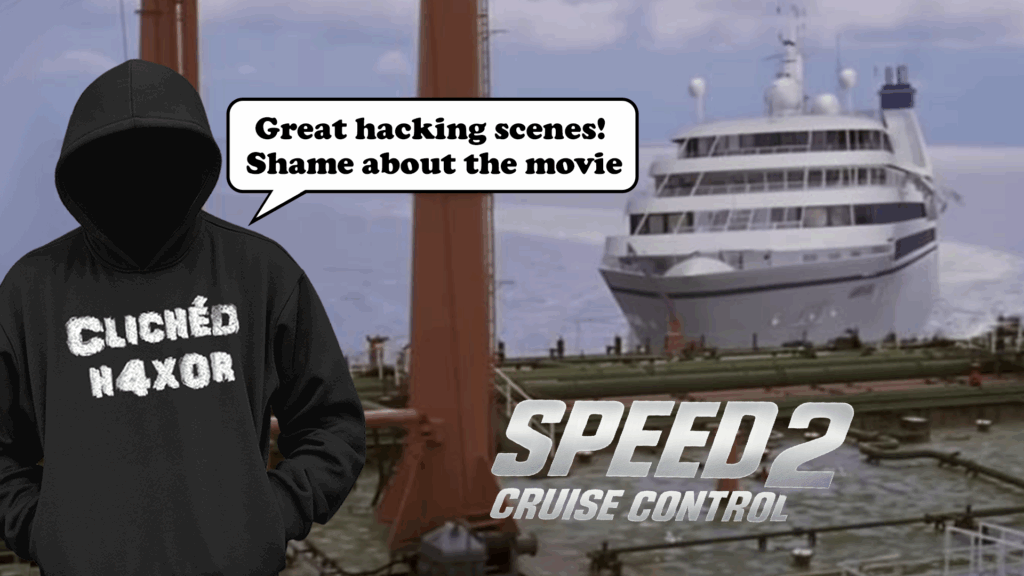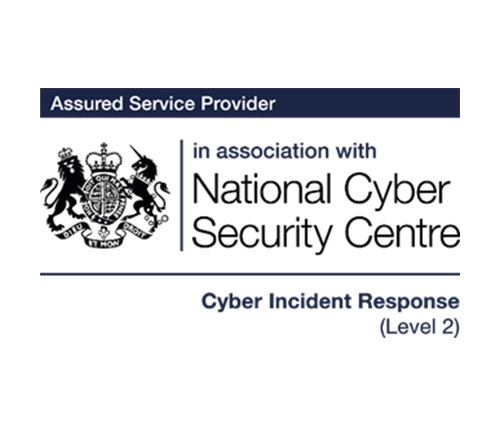TL;DR
- What Speed 2: Cruise Control got right and wrong about hacking ships
- Some are genuinely plausible, even 30 years later. Others are pure movie magic
- Modern cruise ships are a challenge to secure, owing to complexities around IT ,OT and external connectivity
- Regulations like IACS UR E26/E27 and US Coastguard 33 CFR Part 6 now push operators to tighten controls.
Introduction
In the field of maritime cyber, we often cite the movie Speed 2: Cruise Control from 1997 as an interesting prediction of the future. It illustrates the reality of today quite well, despite being nearly 30 years old!
It’s not a great movie, but the hacking concepts shown in it are actually fairly plausible and just about stand up to scrutiny.
The loose plot (spoilers ahead!)
A recently fired ship’s autopilot software engineer modifies the software on a cruise ship, intending to crash it into an oil tanker. Could it happen? Broadly yes, with time on board and high-privilege physical access. The execution on screen is far-fetched, but the principles are sound.
What can we learn, other than bad acting and scriptwriting?
Hack 1: connecting to the ship’s control network
John Geiger, played by Willem Dafoe, pulls a fibre network cable from the ceiling of his cabin, with the objective of joining the network and taking control of the ship
In reality, critical system cabling in the 1990s was never routed through passenger cabin ceiling voids. Even today, these cables run in dedicated conduits, secured behind locked panels.
The fibre connector shown on screen does look accurate for the period, but Geiger then plugs it into a box that is anything but:

In order to take remote control of the ship’s systems:

Now, I’m old enough to remember these boxes. They certainly aren’t fibre connectors – it’s a serial switch box with a ‘fibre connector’ sticker on it! Artistic licence++, yet there wasn’t any need to fake a fibre connection. An odd choice from the props department

PC visuals were all a bit limited in the 90s; some of these are a fair attempt at reproducing marine control and monitoring interfaces of the time, but some are a bit of a joke!

Here’s Geiger’s laptop UI:
What’s that protocol though?

We had a thorough hunt for early ship serial communication protocols, as there were many, but drew a blank. At the time, serial communications based on NMEA0183 sentences were fairly common. RS485 and 232 were also well used, so why invent ‘QB498/s’? Who knows.
The interface has the look of an early automation and monitoring system HMI, but it’s more likely it was created for the purpose of the movie. Lovely to see command.com first in the list !

Conclusion: plausible in principle, but the access method to the core network is a bit fanciful
Hack 2: compromising engine controls
Geiger creates a distraction in the engine room, allowing him to connect a device to an ‘Engine Room Status’ device.

That device appears to be a Symbol PPT4600 handheld barcode scanner! It does feature a handy serial interface though, which would be good for the next step:
He connects it to a 15 pin d-sub connector and makes some changes, which we assume are related to the ability to shut down the engines remotely later on.

Conclusion: plausible, just
Hack 3: stopping the engine and causing a huge vibration
Stopping the engine. It doesn’t take 10 minutes to stop a ships engine. It takes a few seconds, mostly owing to the rotational momentum of large masses such as the prop shaft. It seems likely that the movie purposefully included a 10-minute engine stop time to create a sense of suspense.
The Seabourn Legend is a real ship, so we can check out the veracity of this claim. It was hired for filming for six weeks at a cost of ~$40k/day. It does have four engines, but shutting one down would not result in the huge vibration seen in the movie! Slamming one in to reverse, a full crash stop, would cause huge vibration, but that’s not what is shown.
There are also explosions seen in the engine room, suggesting that the ‘top end’ covers were blown off. That’s not how an engine failure would be seen. However, the crew could still stop the engine manually. All large marine engines have manual shut-offs, even if that means turning off the fuel supply. Losing total control of an engine just wouldn’t happen.
A modern electronically controlled engine could very likely be made to throw itself to pieces if one could alter injection timing. An incident happened in 2021 where a coupling to an injection pump failed, resulting in an injection timing issue and then a significant fire!
Conclusion: implausible in the context shown, but probably more plausible for more recent engine control systems
Defending against Geiger
1: Adding ballast water to the ship
The ship’s crew decide to add ballast water to slow the ship down. Adding ‘a million litres of water’ is plausible for a ship of the size of the Seabourn Legend. Adding ballast would slow the ship in the manner shown. That said, cruise ships typically carry ballast water for trim – ensuring they are trimmed fore or aft for efficiency. By mis-trimming the vessel with ballast water, say to the forward ballast tanks, it would slow more than demonstrated.

However, the movie shows opening ballast water doors to accessible deck areas! Ballast tanks would be sealed when at sea. They are only accessed infrequently for inspection and cleaning, through small covers secured with bolts.

Conclusion: plausible as a method of slowing the ship, implausible as a method to flood decks.
2: Jamming the rudder
The character played by Jason Patric attempts to swim under the vessel and wrap a steel cable around the propellor. Now, I’ve had unintentional prop wraps on yachts I’ve sailed, so I know that wrapping things around the propellor causes issues with propulsion!

But it simply isn’t necessary in the real world: one would simply take manual control of the steering gear!
Before setting sail, every sizeable vessel will carry out a manual steering check. One would access the steering gear room and actuate the hydraulic rams that move the rudder directly. But that’s no fun!
Conclusion: plausible, if pointless
3: Manually winding the bow thruster
The previous two defences were plausible, if pointless. The last one is utterly ridiculous:
As the crew has lost control of the helm (ability to steer the ship), as a last resort the Patric character is directed to the bow thruster controls. These, of course, are underwater..


He manually winds the bow thruster, causing the ship to change direction and only strikes the oil tanker with a glancing blow.

Problem 1: a bow thruster on a vessel of this size needs upwards of 1MW of power. Winding a handle manually is going to generate a few Watts of power. So this doesn’t work
Problem 2: the autopilot has been compromised and is holding a fixed course. It would simply correct any deviation and plough straight into the tanker
Conclusion: totally fanciful
Bringing it up to date
Does the movie represent cruise ship security today? Not really. Cruising has become significantly more complex with the advent of always-on internet connectivity and numerous connected systems to drive safety and efficiency.
If anything, it’s become somewhat harder to secure cruise ships: they combine propulsion, navigation, and power generation with a hotel, restaurant, casino, and theatre, plus safety and fire control systems. That complexity makes maintaining strict separation between OT and IT a real challenge.
However, most operators are making big leaps forward in securing their vessels. Regulations such as IACS UR E26 &27, together with US Coastguard 33 CFR Part 6 are helping drive behaviours too.
As ever, don’t believe everything you see in the movies. Acting aside, Speed 2 does a reasonable job of showing some ship hacking scenes though others are laughable.
If you want to learn more about genuine ship security issues, there’s a stream of blog posts on the subject here.














